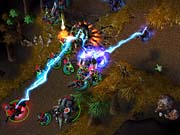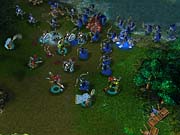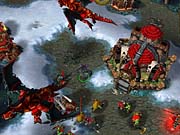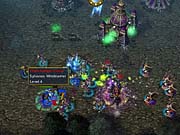Warcraft III: Reign of Chaos needs little introduction, and neither does Blizzard, the company that created it. The worldwide July 3 release of Warcraft III, which shipped about 5 million copies in its first run, seems like a suitably momentous occasion, given that the game itself is both so highly anticipated and has been such a long time in the making. Considering that many have long since preordered the game and that the remaining copies are likely to fly off the shelves, giving a critique of Warcraft III almost seems like a moot point. It's like trying to convince someone whether or not to go see a movie like Star Wars: Episode II. Fortunately for those who intend to play it no matter what anyone says, they'll find their time with Warcraft III to be very well spent. Sure, Warcraft III isn't a revolutionary departure from the conventions of real-time strategy gaming. But it's as good of an offering in the genre as there's ever been, featuring a superb story, carefully refined gameplay, plenty of depth, the best online multiplayer mode in any real-time strategy game to date, and the excellent production values you'd expect from a Blizzard product. So if you're looking for some validation to go with your preorder, there you have it.

On the other hand, if you're looking to inform yourself about what's great and what's not quite as great about Warcraft III, read on. As the sequel to one of the undisputed classics of PC gaming, Warcraft III has some very big shoes to fill. The previous Warcraft game, together with Westwood Studios' Command & Conquer, popularized the real-time strategy genre and introduced a number of ideas that remain conventional to this day. And Starcraft, the follow-up to Warcraft II, was an even more phenomenal success. Talk about staying power: Though Starcraft was released back in 1998, a lot of people still play it. Can Warcraft III truly live up to this heritage? Yes. It has everything that made both Starcraft and Warcraft II before it the blockbuster hits that they quickly became. Warcraft III has lots of great characters, and its fantasy-themed world has tons of personality. It's got fine-tuned, well-balanced gameplay, it's got a quick pace, it's got some new gameplay twists that should surprise even the most hard-core real-time strategy gamers, and it's simply a lot of fun. For good measure, it ships with the powerful Warcraft III world editor utility, allowing devout Warcraft III players to build their own maps and scenarios, thus greatly extending the life of the game for themselves and for others.
Make no mistake: Warcraft III is a real-time strategy game. Originally announced back in 1999 as a hybrid strategic role-playing game, over the course of its development, Warcraft III shed many of its role-playing pretensions and became what by all means is a true sequel to its predecessor. The game relies on many of the real-time strategy conventions you're probably familiar with by now. The goal of a typical skirmish is to start gathering resources (gold and wood), build up a base, build up a force of various units, and use that force to destroy the enemy's base and to repel any attacks against your position. You control the action primarily with a mouse by clicking on individual units and buildings or dragging boxes around groups of them, and you can also use predefined keyboard hotkeys to quickly perform some actions. So Warcraft III doesn't reinvent the wheel.
What it does is let you play as four different, uniquely appealing factions. The human alliance, which comprises elves, dwarves, and humans, returns from the previous Warcraft games, as does the orcish horde, consisting of the brutal green-skinned orcs, the trolls (their wicked cousins), and a minotaurlike breed called the tauren. The entirely new playable factions include the undead scourge, a mix of evil human occultists and their nefarious zombie creations; and the night elf sentinels, a purple-skinned race of warrior druids. The game reduces the scale of the typical real-time strategy battle, putting you in charge of a relatively small number of powerful units rather than countless weaker ones. Warcraft III also lets you recruit hero characters who start out strong and soon grow even mightier as they gain experience from battle. Hero characters aren't just powerful in their own right--they can often bolster the abilities of nearby units, making them an essential component of any Warcraft III army. Furthermore, Warcraft III's colorful maps tend to be populated by plenty of dangerous denizens, together with your main opponents. These creatures can bar passage to key strategic locations, and defeating them earns your hero character much-needed experience, as well as some valuable artifacts.

Warcraft III adds some much-needed variety to the traditionally slow early stages of a real-time strategy battle. Typically, the initial build-up period in such games is merely a race to get to the best units first. That's somewhat true of Warcraft III, but at least you're not just going through the paces while you construct your base. Instead, in a typical match against the computer or other players, you need to quickly assemble a small force for your hero and get out there and start exploring and fighting, because experienced heroes are far more powerful than inexperienced ones. Exploring the territory and battling miscellaneous monsters makes the early game plenty interesting in Warcraft III, especially since you need to keep checking on your base. Even choosing your starting hero makes for a significant early decision, as each faction has three available--typically some sort of pure fighter (like the samurai-like orc blademaster), a support fighter (like the human paladin), and a caster (like the undead lich). Later, you can have all three of your faction's heroes out in the field simultaneously--however, only your first one is free. All heroes gain up to four unique special abilities as they gain experience levels, which can turn the tide of a battle when used correctly. Every hero type is different, viable, and deadly, so even learning which ones your opponents have selected is important, giving you yet another reason to quickly try to scout out enemy encampments.
Blizzard's real-time strategy games have been criticized in the past for strictly limiting the number of units that a player could select at any given time. In Starcraft, players would often form half a dozen or more full groups of units and send them off all at once to obliterate the enemy. Not being able to select scores of units simultaneously was a mere inconvenience. But in the context of Warcraft III's concentrated battles, your ability to command only a limited number of units makes more sense. You're limited to selecting no more than 12 units at a time, and the maximum number of units you can have on the field is quite low. You can build a sizable attack force and leave a minimal garrison back at base, and that's about it. So you can't usually win by sheer numbers. Additionally, Blizzard has introduced the concept of upkeep to the formula, which causes your gold miners to generate less income the more units you have. These artificial constraints may initially be frustrating to those accustomed to other real-time strategy games, including Blizzard's own Starcraft, and they do diminish the sense that you're commanding vast armies, because you're not.
But in time, most anyone should appreciate the balance that these rules create. Essentially, the low unit count and upkeep system encourage you to stick with a relatively small number of units and to spend your resources on upgrading them wisely. Defensive behavior won't win the day in Warcraft III. You have to get out there and fight and gain experience, and if your units die, you need to make more. You'll either be spending gold on more units or losing it to high upkeep costs in the long run, after all. Even if your hero character is killed in combat, he or she may be revived (for a fee) back at your base.
And lest you think Warcraft III is all about rushing your opponent as quickly as possible, rest assured each of the four factions has its own unique defenses. Human peasants can take up arms and become militia, defending their base from any aggressors. Orc peons can dive into their burrows, from which they can toss spears to deadly effect against their foes. The undead have early access to ghouls, misshapen foot soldiers who also double as lumberjacks. And most of the night elves' "buildings" are actually sentient tree creatures that can uproot themselves and literally fight back against any threats. So in practice, the four factions of Warcraft III are nearly as different as they look. They are uniformly similar only to the extent that it makes sense for gameplay purposes--in that they share roughly analogous buildings and technology trees and have a few similar types of units. So you'll be able to get a basic grasp of any of the races quickly and be able to switch from one to the next easily. But you'll still notice and appreciate the many differences between the four sides, like how the orcs are the flat-out strongest race, while the undead can best rely on overwhelming numbers and subversive tactics. Meanwhile, the humans are the most technically advanced, while the night elves have many ranged units and some devious special abilities. Overall, Warcraft III's four factions are unusual, fun to play, and almost as different as the three factions from Starcraft.
Regardless of the faction you prefer, you'll find that Warcraft III's interface truly shines. It's not overly complex, and in some ways, it's even a bit limiting--for example, it doesn't let you remap the keyboard hotkeys. But in practice, Warcraft III's interface really gets the job done. Or rather, it lets you get the job done. Grouped units automatically assemble and move in formation, with the tougher ones tending to get in front. You can easily set waypoints and issue attack-move orders, making your units spread out and engage any enemies on the way to their destination. Units won't automatically get out of the way for each other, which can occasionally cause some problems with unit pathfinding, but this is of marginal concern. You can hit the space bar to quickly jump to any event that's happening on the battlefield, your minimap clearly displays your surroundings, and an icon pops up whenever one of your worker units is standing idle. For that matter, detailed help windows pop up when you float your cursor over just about anything. That's all good, though it's all been done. Warcraft III also introduces the concept of subgroups, allowing you to hit the Tab key to cycle between all units of a single type within a group. Thus, you can easily cast spells and use your units' special abilities, even when you have mixed groups selected. It's a great feature.

More importantly, the way the action plays out in a typical match is really outstanding, which is something that's as rare in real-time strategy games as it is difficult to describe. Everything just feels right. You see the hit point meters of enemy units deplete precisely at the moment they're struck by your forces. Hero units, and most units for that matter, can take a beating before they die, which sometimes affords you with enough time to pull them out of a battle and heal them up so that they might live to fight another day. Buildings can withstand a lot of damage from most types of units even for lengthy periods of time, though specialized siege weapons can quickly destroy them. Day turns to night (and back again) over the course of a match, a nice aesthetic touch that also realistically reduces most units' line of sight, while affording you with some subtle strategic opportunities. Your starting base probably won't be enough to sustain the forces you'll need to win, since gold is limited, so seeking out expansion areas and building new bases there is all part of the midgame challenge. And the endgame turns into full-on tactical combat, where the player who best anticipates his opponent and brings the biggest variety of forces to bear will probably win.
Warcraft III truly requires you to use mixed forces to succeed. Ground forces, ranged units, flying support troops, and spellcasters, along with your heroes, are all needed for victory. That sounds like a lot, and it is, yet the smaller scale of the battles, the perfect pacing, and the ability to set certain special abilities to trigger automatically all make Warcraft III as manageable to play as it is fun. The best Warcraft III players will have the uncanny ability to micromanage everything at once. But most Warcraft III players will still have a great time using their heads, as well as their reflexes, while not getting bewildered.
Seemingly the only aspect of Warcraft III that Blizzard didn't fully reveal ahead of time was the game's single-player story mode, comprising four campaigns, which weave an involving, entertaining, memorable story from the perspective of each of the four factions. The campaigns need to be played through in order, and each consists of between seven and nine missions and is like a self-contained story unto itself. There's great variety to the missions, and a number of the mission goals are completely original. In the end, the story leaves some loose ends conspicuously untied, affording Blizzard plenty of room for an encore in the inevitable Warcraft III expansion pack. However, to say that a lot of interesting, surprising things happen in the campaigns would be an understatement. The campaigns are made interesting by their strong casts, as the action will revolve around various hero characters whom you'll control and see grow more powerful from one mission to the next. Each character is brought to life using first-rate voice-over, which conveys each personality distinctly and vividly. Unfortunately, though, the speech isn't lip-synched with the animated character portraits.

There are no mission-briefing screens in between campaign scenarios--instead, you'll see plot-driven cutscenes using the game's 3D engine. These tend to zoom in on the game's 3D characters a bit too close. Plus, they don't look that great, but they still work well to keep you motivated to complete each mission. On normal difficulty, the missions aren't very tough (though on the hard setting, they certainly are). Still, an easy difficulty option becomes available if you lose--that way, everyone can reach the ending of the game without too much trouble. New players will also appreciate Warcraft III's optional story-driven prologue campaign, which walks you through every basic aspect of gameplay in the context of a couple of story-driven missions. Between campaigns, you'll be treated to prerendered cinematics that represent the cutting edge of computer graphics. It's easy to find yourself wishing for a feature-length Warcraft movie after seeing these, which serve as a great reward between segments of a single-player mode that's consistently rewarding anyway.
The campaigns are a good length, and once you're finished with them, you can try your hand against the computer in a custom game. If you played through the campaign on normal difficulty, you'll find that the computer is much, much tougher in skirmish mode. It plays ideally and controls its heroes expertly, making for a truly capable yet perhaps overly efficient opponent. You can tell that the artificial intelligence was designed to put up a good fight against even some of the most highly skilled players. On the other hand, the average Warcraft III player might not like getting stomped, but he or she has the option of teaming up with the AI and observing its meticulous tactics firsthand. You'll learn about most every unit and pick up a lot of good strategies in the campaign, but to really pick up on how best to play Warcraft III, you can start by watching the AI do its thing. There are more than 40 maps (and two surprising minigames) available in the custom game mode, and maps are suitable for anywhere from two to 12 players. Needless to say, the dynamic of a 12-player onslaught is very different from a focused two-player engagement, and there's a real diversity in the maps themselves, lending Warcraft III a great deal of variety.
Of course, the real variety comes from playing other human opponents, and Blizzard's proprietary, free Battle.net service lets you do just that--and more easily and better than ever. Now, once you log on to Blizzard's servers, you can just click on the "play game" button, and Battle.net will automatically pit you against an opponent or opponents looking for a similar type of match. You'll ideally be put in a game with players whose win/loss records are similar to yours. There's even an "arranged teams" option where you and one or more friends can quickly get into matches against other teams of players. To facilitate this, Battle.net now lets you conveniently track when your friends are online and what they're up to, whether they're in a match or chatting in the lobby. It's never been easier to just get online and start playing, something that more-casual players should really appreciate. Meanwhile, hard-core players will of course start racking up wins, in hopes of earning a high ladder rank. In short, Blizzard's improvements to the Battle.net service help make Warcraft III's online multiplayer mode the most accessible of any real-time strategy game to date. Plus, the presence of four different Battle.net servers around the world helps ensure that online play is smooth for everyone, even in matches with eight to 12 players.

If you've visited Blizzard's Web site in the past year or two, then you have a good idea of what Warcraft III looks and sounds like. And it looks and sounds superb. The fact that the game uses an entirely new 3D engine was a big surprise when Warcraft III was first announced, but it seems perfectly natural. Units have as much personality as ever in a Blizzard game and are animated even more smoothly. The terrain often looks even better than the units, as the maps are all very colorful and beautifully rendered. Details abound, such as how bodies of various shapes and sizes and blood and ichor of various colors can all be seen in the aftermath of a battle, delivering the impression that a great battle just took place. Some of the graphical quality is inconsistent--you may notice that some unit portraits seem to look much, much better than others. But overall, Warcraft III is a terrific-looking game, and it is one that demonstrates that a fully 3D graphics engine truly can replace everything that's great about 2D graphics. Warcraft III sounds as good as it looks. Each faction has its own uniquely fitting musical accompaniment, though the undead's and night elves' music sounds the best. The heavy-hitting sounds of battle are simply perfect, and the various units' personalities really come across from their voices, though units do have a pretty limited number of speaking lines. In proud Blizzard tradition, if you keep clicking on a unit, it will begin to make outrageous comments that are often hysterically funny.
Warcraft III is a must-have game, and you don't need a game review to tell you so to know it's true. The fact that so many people will have already put money down for the game by the time you read this demonstrates how much faith gamers all across the world have in Blizzard's products. And Warcraft III once again suggests that this is faith well placed. So if you've ever enjoyed a real-time strategy game from Blizzard, then you'll undoubtedly enjoy Warcraft III: Reign of Chaos. And even if you're skeptical and approach it with extreme caution, wondering whether mere mob mentality is what makes people flock to this particular product, you'll still eventually find that the reasons for Warcraft III's popularity are pretty straightforward. It's just an outstanding game, filled with all the charm, all the detail, and all the lasting appeal that characterizes all of the finest games ever made.